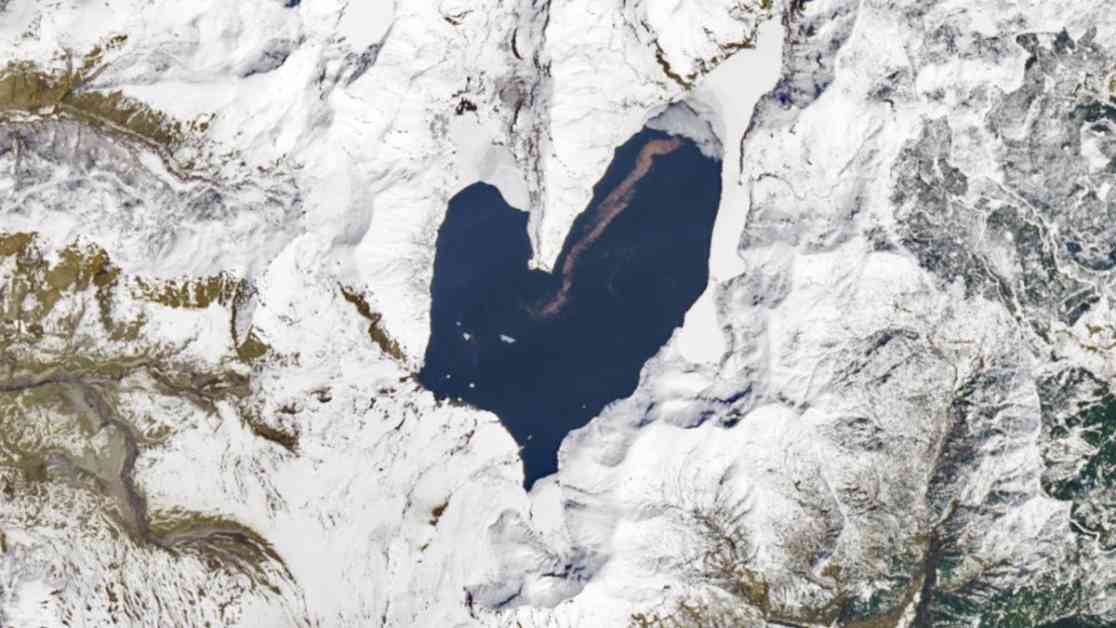In the wake of Mount St. Helens’ catastrophic eruption in 1980, Spirit Lake underwent a dramatic transformation, emerging as a heart-shaped body of water nestled just three miles north of the volcano’s summit. This remarkable change, captured in a striking satellite image taken on April 26, 2023, showcases the resilience of nature in the face of adversity.
The eruption itself, triggered by a 5.1 magnitude earthquake at 8:32 a.m. PDT on May 18, 1980, unleashed a series of catastrophic events that reshaped the landscape surrounding Mount St. Helens. The initial landslide and subsequent explosion resulted in the loss of 57 lives and caused extensive damage amounting to $1 billion. The aftermath of this disaster left Spirit Lake with a new identity, its once-divided arms now united in the unmistakable shape of a heart.
Prior to the eruption, Spirit Lake boasted a smaller footprint with two distinct arms connected by a narrow passage, resembling the top half of a heart, as described by NASA’s Earth Observatory. The landslide and explosion altered the lake’s contours, expanding its dimensions and elevating its surface by around 200 feet. The lake, now covering approximately 4.5 square miles, serves as a poignant reminder of the enduring impact of natural disasters.
### Monitoring Nature’s Resilience
Despite its transformation, Spirit Lake remains under close scrutiny by scientists eager to understand how ecosystems rebound in the aftermath of such catastrophic events. The lake, once a bustling tourist destination with numerous camps and cabins along its shores, now stands as a symbol of nature’s remarkable ability to heal and regenerate.
Today, restrictions prevent human activities such as fishing and swimming in Spirit Lake, allowing researchers to observe the lake’s ecosystem undisturbed. The presence of a log raft formed by uprooted trees during the eruption serves as a unique focal point for scientists studying the lake’s recovery. This raft, visible as a brown streak in the satellite image, has likely become an integral part of the lake’s ecosystem, offering insights into the interplay between natural forces and ecological resilience.
### A Tale of Transformation and Renewal
In the years following the eruption, Spirit Lake experienced a resurgence of life that defied initial expectations. Despite the presence of uprooted trees covering up to 40% of the lake’s surface and the anoxic conditions resulting from volcanic gases, signs of revitalization began to emerge. In 1983, scientists observed the growth of phytoplankton on the lake’s surface, a crucial step in restoring oxygen levels and fostering a new cycle of life within the lake.
The construction of a drainage tunnel in 1985 helped prevent the lake from overflowing and mitigated the risk of catastrophic floods in the surrounding area. This intervention, coupled with nature’s own regenerative processes, set the stage for the ongoing recovery of Spirit Lake and its surrounding ecosystem.
As we reflect on the enduring legacy of Mount St. Helens’ eruption and the transformation of Spirit Lake into a heart-shaped symbol of resilience, we are reminded of nature’s ability to heal and adapt in the face of adversity. The story of Spirit Lake serves as a testament to the interconnectedness of natural processes and the enduring spirit of life in even the most challenging environments.










